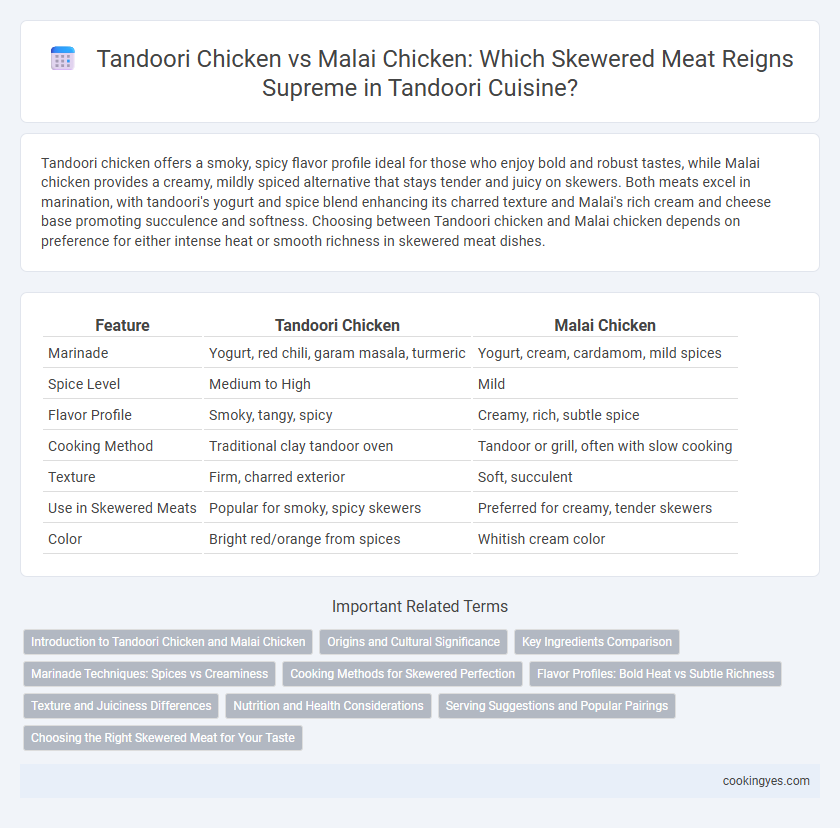Tandoori chicken offers a smoky, spicy flavor profile ideal for those who enjoy bold and robust tastes, while Malai chicken provides a creamy, mildly spiced alternative that stays tender and juicy on skewers. Both meats excel in marination, with tandoori's yogurt and spice blend enhancing its charred texture and Malai's rich cream and cheese base promoting succulence and softness. Choosing between Tandoori chicken and Malai chicken depends on preference for either intense heat or smooth richness in skewered meat dishes.
Table of Comparison
| Feature | Tandoori Chicken | Malai Chicken |
|---|---|---|
| Marinade | Yogurt, red chili, garam masala, turmeric | Yogurt, cream, cardamom, mild spices |
| Spice Level | Medium to High | Mild |
| Flavor Profile | Smoky, tangy, spicy | Creamy, rich, subtle spice |
| Cooking Method | Traditional clay tandoor oven | Tandoor or grill, often with slow cooking |
| Texture | Firm, charred exterior | Soft, succulent |
| Use in Skewered Meats | Popular for smoky, spicy skewers | Preferred for creamy, tender skewers |
| Color | Bright red/orange from spices | Whitish cream color |
Introduction to Tandoori Chicken and Malai Chicken
Tandoori chicken is a flavorful Indian dish featuring marinated chicken cooked in a traditional clay oven called a tandoor, known for its smoky aroma and vibrant red color due to spices like chili powder and turmeric. Malai chicken offers a creamy contrast with a marinade of yogurt, cream, and mild spices, resulting in tender and mildly spiced meat. Both dishes are popular skewered meats distinguished by Tandoori's bold spice profile and Malai's rich, smooth texture.
Origins and Cultural Significance
Tandoori chicken originates from the Punjab region of India and Pakistan, traditionally cooked in a clay tandoor oven, embodying rich cultural heritage and festive significance in South Asian cuisine. Malai chicken, also known as creamy chicken, features a milder, dairy-based marinade with origins in Mughlai cuisine, reflecting the fusion of Persian and Indian culinary traditions. Both dishes hold important cultural roles, with tandoori chicken symbolizing rustic, smoky flavors, while malai chicken represents royal indulgence and subtlety in skewered meat preparations.
Key Ingredients Comparison
Tandoori chicken features a marinade rich in yogurt, turmeric, red chili powder, and garam masala, imparting a smoky, spicy flavor profile highlighted by its vibrant red color from Kashmiri chili. Malai chicken skews towards a creamy texture with key ingredients like cream, cheese, mild green chilies, and cardamom, offering a rich, smooth taste with subtle aromatic notes. Both meats rely on skewering and tandoor cooking but differ distinctly in their marinade compositions that define their unique culinary identities.
Marinade Techniques: Spices vs Creaminess
Tandoori chicken utilizes a vibrant marinade of yogurt blended with bold spices like cumin, coriander, garam masala, and red chili powder, infusing the meat with smoky, tangy heat when cooked in a traditional clay tandoor. In contrast, Malai chicken relies on a creamy marinade enriched with heavy cream, cashew paste, and mild aromatic spices such as cardamom and nutmeg, resulting in tender, rich, and subtly sweet skewered meat. The key distinction lies in Tandoori's spice-driven, fiery profile versus Malai's smooth, luscious texture achieved through cream-based marination.
Cooking Methods for Skewered Perfection
Tandoori chicken achieves its characteristic smoky flavor and charred texture through high-heat cooking inside a clay tandoor oven, where marinated meat cooks quickly over intense radiant heat. Malai chicken, on the other hand, relies on a creamy marinade with yogurt, cream, and mild spices, and is typically cooked at moderate temperatures to ensure tenderness without charring. Both methods require precise timing and skewering technique to maximize even heat exposure, with tandoori favoring direct, dry heat and Malai benefiting from slower, moist-heat cooking for skewered meat perfection.
Flavor Profiles: Bold Heat vs Subtle Richness
Tandoori chicken delivers a bold flavor profile characterized by fiery spices, smoky char, and tangy yogurt marination that creates an intense, vibrant heat. Malai chicken offers a subtle richness with creamy, mild spices, and tender marinated meat that balances gentle aromatic flavors and smooth texture. Both skewered meats highlight unique regional taste preferences, making Tandoori chicken ideal for spice enthusiasts and Malai chicken perfect for those seeking mellow indulgence.
Texture and Juiciness Differences
Tandoori chicken features a spiced yogurt marinade that creates a smoky, charred exterior with a firm, slightly dry texture, ideal for those who prefer a robust and intense flavor. Malai chicken uses a creamy, mild marinade with cream and cheese that results in a tender, succulent bite and noticeably higher juiciness. The difference in texture and moisture content stems from the marinade composition and cooking technique, influencing each dish's appeal for skewered meats.
Nutrition and Health Considerations
Tandoori chicken is lower in fat and calories compared to Malai chicken, making it a healthier option for those seeking lean protein with minimal added fats. Malai chicken contains cream and cheese, increasing its saturated fat content, which may impact heart health if consumed frequently. Both offer high protein levels, but Tandoori chicken aligns better with a balanced diet focused on weight management and cardiovascular wellness.
Serving Suggestions and Popular Pairings
Tandoori chicken pairs exceptionally well with fresh naan and tangy mint chutney, while Malai chicken is often served with creamy raita to balance its rich flavors. Both dishes complement basmati rice or a simple vegetable pulao to enhance their aromatic spices. Popular sides include grilled vegetables and pickled onions, which add texture and a burst of flavor to the skewered meat experience.
Choosing the Right Skewered Meat for Your Taste
Tandoori chicken offers a smoky, spicy flavor profile with marinated yogurt and robust Indian spices, ideal for those craving intense heat and charred texture on skewers. Malai chicken provides a creamy, mild alternative, marinated in cream, cheese, and subtle spices, perfect for diners preferring tender, juicy meat with smooth, rich flavors. Selecting between Tandoori and Malai chicken hinges on individual taste preferences for bold spiciness versus delicate creaminess in skewered meats.
Tandoori chicken vs Malai chicken for skewered meats Infographic

 cookingyes.com
cookingyes.com